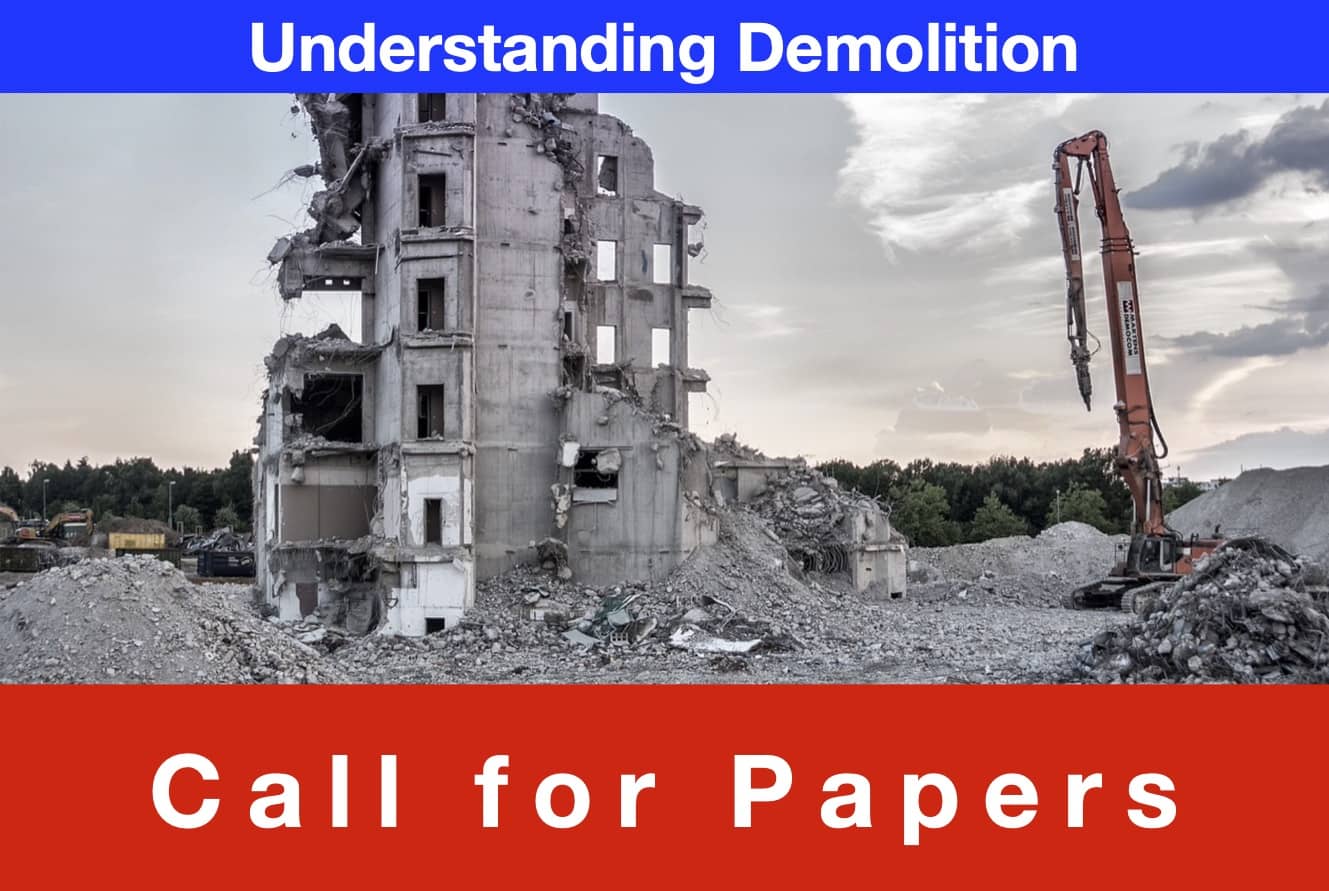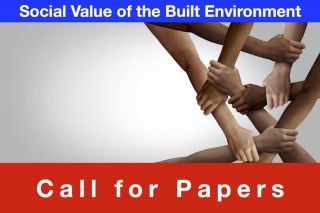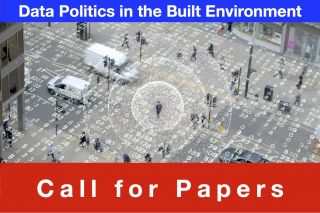
www.buildingsandcities.org/calls-for-papers/understanding-demolition.html
Understanding Demolition

Guest Editor: Satu Huuhka (Tampere U)
Abstract submissions closed on 7 October 2022
Is it environmentally, economically, socio-culturally more sustainable to extend buildings' lives or to build new? What are the specific challenges, potentials, and contributions for retaining existing buildings as opposed to their demolition and replacement? What are the drivers for the demolition of buildings? How can a more sustainable approach be created? How can retention and adaptive change be applied in different conditions and different scales (buildings, neighbourhoods, building stocks)?
Demolition / deconstruction has so far mainly been approached as a technical undertaking of engineering. Building preservation is primarily framed as historic conservation i.e. rarity, architectural quality, historic role, etc). Social scientists (e.g. Gilbert, 2009) have criticised mass-replacement policies and the consequences for underprivileged people who are dislocated. There has been relatively little problematisation both in- and outside of academia whether and when demolition should be performed, apart from Thomsen et al. (2011) and the RetroFirst campaign in the UK by the Architect's Journal (2019).
Aims
The special issue will explore why demolition occurs with the aim to understand its environmental, socio-economic and cultural drivers, potentials and consequences, as well as policy and practices pertaining to avoiding demolition at different scales - supra-urban (country/region), urban (city/neighbourhood), building stock and building scale. How can planners and other stakeholders compare alternatives for densification without demolition i.e. by extending and infilling? What drives the replacement of existing buildings with new ones, what are the wider environmental, economic, and socio-cultural impacts on the sustainability of cities, and whether short-term financial gain is too privileged compared to other concerns. Submissions are welcomed that examine these phenomena in the different contexts of shrinking/growing communities. Contributions that explore the impacts of demolition from various viewpoints and multiple perspectives (urbanism, urban planning, obsolescence, resource efficiency, mass flows, embodied carbon, social value, etc.) are particularly welcome.
Context
Most of the developed world's future cities already exist: most of the existing building stock will remain for decades if not centuries to come. However, in the sustainability discourse, the long-lasting nature of buildings is rarely celebrated. Older (domestic and non-domestic) buildings tend to be seen either as a problem and a threat, e.g. a contributor to climate change due to their allegedly excessive use of energy or, if they are heritage buildings, as being themselves threatened by the changing climate. Recently, new knowledge has emerged that challenges this perception, suggesting that older can potentially outperform new build as highlighted below.
First, as the focus is shifting from buildings' operational energy consumption towards whole life carbon impacts, there has been a growing acknowledgement of embodied emissions (e.g. Röck et al. 2020). New build is inherently disadvantaged in this regard, as an existing building avoids further embodied emissions and waste generation. Second, the decarbonisation of energy supply is reducing the emissions from the in-use phase (Kuittinen & Häkkinen 2020), thus further increasing the significance of the embodied emissions.
Third, many existing buildings may already perform better than is the regular preconception (Sunikka-Blank & Galvin 2012) and there may be potential to reduce their consumption even further.
Fourth, due to differing temporal dimensions in which embodied and operational emissions are released, life cycle extension typically outperforms new build in the near future, i.e. in the timeframe most crucial to climate change mitigation (Heinonen et al. 2011).
Fifth, the existing economic arguments for demolition and rebuilding are contentious. Life cycle extension is typically more affordable for tenants, but redevelopment can create greater profits for the developer. Redevelopment increases property prices which often impacts negatively on affordability by displacing existing people and businesses. Not all incurred environmental, social and financial burdens are accurately converted into costs in our present economic system.
At the neighbourhood and urban scale, demolition of existing low- and middle-rise areas is often done to increase density. Denser urban structures in well-connected areas are believed to contribute positively to sustainability. However, the CO2 impacts for the two alternatives are rarely quantified in a satisfactory manner to account for embodied (both buildings and infrastructure) and operational (buildings and traffic) emissions and how they accumulate over time.
There is a pressing need for a wider and deeper understanding, but making comparisons is complicated and data intensive. Researching demolition and the prospects for its avoidance are further complicated by difficulties in accessing relevant data. Cadastral data on demolition is usually fragmented, not centrally collected and maintained, and/or lacks detail. Thus, different approaches and methods are needed in different contexts depending on the existence, availability and quality of data.
Suggested topics
The suggested topics for this special issue include, but are not limited to:
Dynamics of demolition vs. preservation on the building stock level
- Spatiotemporal patterns of demolition vs. preservation
- How vacancy may or may not be connected to demolition
- Drivers, motives, incentives and/or barriers for demolition or preservation
- Particularities in different types of contexts, e.g. shrinking or growing communities
- More balanced approaches to economic, environmental and social criteria for demolition
Impact assessment
- Environmental and/or economic performance of existing buildings in comparison to demolition and new build
- Social and/or cultural consequences of demolition
- Wider economic impacts of demolition and redevelopment e.g. higher costs of premises, externalised environmental costs
- Demonstrable impacts of life cycle extension measures over the long term, e.g. a longer service life
Approaches and methods on the building level
- Mechanisms of building obsolescence, their identification and mitigation (Thomsen & van der Flier 2011; Thomsen et al. 2015; Abrahamson 2016)
- Untapped adaptation potentials of existing buildings and assessment thereof
- Case studies of buildings, preferably representative multi-case studies of building types or ages prone to demolition
- Case studies of existing buildings with minor interventions to extend their life and improve value e.g. extensions, accessibility improvements, etc.
- Design qualities / morphological characteristics that enhance building longevity
- Technical alternatives to demolition, e.g. deconstruction, pre-planned disassembly, design for disassembly and adaptability
Policies, tools and skills
- Planning and economic policies / strategies / criteria to support stewardship, continued use over demolition and their consequences
- Policies, strategies and criteria for enhancing the longevity of the existing building stock
- Policies, strategies and criteria for enhancing the longevity of new buildings
- Appropriate data, indicators and measures for monitoring demolition and its avoidance as a part of policy implementation
- Practical and professional skills needed to enhance the existing building stock and extend its life
- The role of circular economic policies & practices on reducing demolition / extending service life
Briefing note for contributors
You are invited to submit an abstract for this special issue. Please send a 500 word (maximum) abstract to editor Richard Lorch richard@rlorch.net by 07 October 2022. Your submission must include these 3 items:
- Your the author's and all co-author's names, institutional & departmental affiliations and contact details
- the question(s) in this Call for Papers that the abstract and intended paper address
- the abstract (300 - 500 words maximum) defining the research question(s), scope, methods and results
Abstracts will be reviewed by the editors to ensure a varied, yet integrated selection of papers around the topic. Authors of accepted abstracts will be invited to submit a full paper (6000-7500 words), which undergoes a double-blind review process.
Buildings & Cities is an international, open access, double-blind peer-reviewed research journal. Its focus is the interactions between buildings, neighbourhoods and cities by understanding their supporting social, economic and environmental systems. More information can be found online: www.buildingsandcities.org & published papers are found here: https://journal-buildingscities.org
Open access and Article Processing Charge
Buildings & Cities is an open access journal and has an article processing charge (APC) of £1200. If you do not have institutional support, please contact the editor when submitting your abstract. We endeavour to assist those without funding.
Questions?
If you have a question, please contact:
Richard Lorch
or Satu
Huuhka
Timeline
|
Abstracts due |
07 October 2022 |
|
|
Full papers due |
15 February 2023 |
(NB: authors can submit sooner if they wish) |
|
Referees' comments |
15 April 2023 |
|
|
Final version due |
June 2023 |
|
|
Publication |
October 2023 |
(NB: papers are published as soon as they are accepted) |
References
Abrahamson, D.M. (2016). Obsolescence: An Architectural History. Chicago: University of Chicago Press. ISBN: 9780226478050
Architect's Journal. (2019). RetroFirst. https://www.architectsjournal.co.uk/news/retrofirst
Gilbert, P. (2009). Social stakes of urban renewal: recent French housing policy. Building Research and Information, 37, 638-648. https://doi.org/10.1080/09613210903186638
Heinonen, J., Säynäjoki, A. & Junnila, S. (2011). A longitudinal study on the carbon emissions of a new residential development. Sustainability, 3, 1170-1189. https://doi.org/10.3390/su3081170
Kuittinen, M., & Häkkinen, T. (2020). Reduced carbon footprints of buildings: new Finnish standards and assessments. Buildings and Cities, 1(1), 182-197. http://doi.org/10.5334/bc.30
Röck, M., Saade, M.R.M., Balouktsi, M., Rasmussen, F.N., Birgisdottir, H., Frischknecht, R., Habert, G., Lützkendorf, T., & Passer, A. (2020). Embodied GHG emissions of buildings - The hidden challenge for effective climate change mitigation. Applied Energy, 258, 114107. https://doi.org/10.1016/j.apenergy.2019.114107
Sunikka-Blank, M. & Galvin, R. (2012). Prebound effect: the gap between performance and the actual consumption, Building Research and Information, 40(3): 260-273. https://doi.org/10.1080/09613218.2012.690952
Thomsen A., Schultmann, F. & Kohler, N. (2011). Deconstruction, demolition and destruction. Building Research & Information, 39(4), 327-332, https://doi.org/10.1080/09613218.2011.585785
Thomsen, A. & van der Flier, K. (2011). Understanding obsolescence: a conceptual model for buildings. Building Research and Information, 39(4), 352-62. https://doi.org/10.1080/09613218.2011.576328
Thomsen, A., van der Flier, K. & Nieboer, N. (2015). Analysing obsolescence, an elaborated model for residential buildings. Structural Survey, 33(3), 201-27. https://doi.org/10.1108/SS-12-2014-0040
Latest Peer-Reviewed Journal Content
A living lab approach to co-designing climate adaptation strategies
M K Barati & S Bankaru-Swamy
Mediation roles and ecologies within resilience-focused urban living labs
N Antaki, D Petrescu, M Schalk, E Brandao, D Calciu & V Marin
Negotiating expertise in Nepal’s post-earthquake disaster reconstruction
K Rankin, M Suji, B Pandey, J Baniya, D V Hirslund, B Limbu, N Rawal & S Shneiderman
Designing for pro-environmental behaviour change: the aspiration–reality gap
J Simpson & J Uttley
Lifetimes of demolished buildings in US and European cities
J Berglund-Brown, I Dobie, J Hewitt, C De Wolf & J Ochsendorf
Expanding the framework of urban living labs using grassroots methods
T Ahmed, I Delsante & L Migliavacca
Youth engagement in urban living labs: tools, methods and pedagogies
N Charalambous, C Panayi, C Mady, T Augustinčić & D Berc
Co-creating urban transformation: a stakeholder analysis for Germany’s heat transition
P Heger, C Bieber, M Hendawy & A Shooshtari
Placemaking living lab: creating resilient social and spatial infrastructures
M Dodd, N Madabhushi & R Lees
Church pipe organs: historical tuning records as indoor environmental evidence
B Bingley, A Knight & Y Xing
A framework for 1.5°C-aligned GHG budgets in architecture
G Betti, I Spaar, D Bachmann, A Jerosch-Herold, E Kühner, R Yang, K Avhad & S Sinning
Net zero retrofit of the building stock [editorial]
D Godoy-Shimizu & P Steadman
Co-learning in living labs: nurturing civic agency and resilience
A Belfield
The importance of multi-roles and code-switching in living labs
H Noller & A Tarik
Researchers’ shifting roles in living labs for knowledge co-production
C-C Dobre & G Faldi
Increasing civic resilience in urban living labs: city authorities’ roles
E Alatalo, M Laine & M Kyrönviita
Co-curation as civic practice in community engagement
Z Li, M Sunikka-Blank, R Purohit & F Samuel
Preserving buildings: emission reductions from circular economy strategies in Austria
N Alaux, V Kulmer, J Vogel & A Passer
Urban living labs: relationality between institutions and local circularity
P Palo, M Adelfio, J Lundin & E Brandão
Living labs: epistemic modelling, temporariness and land value
J Clossick, T Khonsari & U Steven
Co-creating interventions to prevent mosquito-borne disease transmission in hospitals
O Sloan Wood, E Lupenza, D M Agnello, J B Knudsen, M Msellem, K L Schiøler & F Saleh
Circularity at the neighbourhood scale: co-creative living lab lessons
J Honsa, A Versele, T Van de Kerckhove & C Piccardo
Positive energy districts and energy communities: how living labs create value
E Malakhatka, O Shafqat, A Sandoff & L Thuvander
Built environment governance and professionalism: the end of laissez-faire (again)
S Foxell
Co-creating justice in housing energy transitions through energy living labs
D Ricci, C Leiwakabessy, S van Wieringen, P de Koning & T Konstantinou
HVAC characterisation of existing Canadian buildings for decarbonisation retrofit identification
J Adebisi & J J McArthur
Simulation and the building performance gap [editorial]
M Donn
Developing criteria for effective building-sector commitments in nationally determined contributions
P Graham, K McFarlane & M Taheri
Join Our Community

The most important part of any journal is our people – readers, authors, reviewers, editorial board members and editors. You are cordially invited to join our community by joining our mailing list. We send out occasional emails about the journal – calls for papers, special issues, events and more.
We will not share your email with third parties. Read more



Latest Commentaries
COP30 Report
Matti Kuittinen (Aalto University) reflects on his experience of attending the 2025 UN Conference of the Parties in Belém, Brazil. The roadmaps and commitments failed to deliver the objectives of the 2025 Paris Agreement. However, 2 countries - Japan and Senegal - announced they are creating roadmaps to decarbonise their buildings. An international group of government ministers put housing on the agenda - specifying the need for reduced carbon and energy use along with affordability, quality and climate resilience.
Building-Related Research: New Context, New Challenges
Raymond J. Cole (University of British Columbia) reflects on the key challenges raised in the 34 commissioned essays for Buildings & Cities 5th anniversary. Not only are key research issues identified, but the consequences of changing contexts for conducting research and tailoring its influence on society are highlighted as key areas of action.